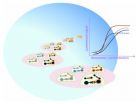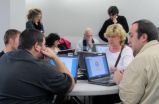(Press-News.org) Scientists have discovered a new pathway the dengue virus takes to suppress the human immune system. This new knowledge deepens our understanding of the virus and could contribute to the development of more effective therapeutics.
For years, the conventional approach to target the dengue virus was through vector control, which was regarded to be the most effective method. This is because the mechanics of the virus have been elusive, which in turn hampered the development of effective treatments and vaccines.
Fortunately a new study, published in the prestigious journal PLOS Pathogens, has given us fresh insight into the virus. Researchers from the Program in Emerging Infectious Diseases (EID) at Duke-NUS Graduate Medical School Singapore (Duke-NUS) have discovered a new way that dengue virus-2 (DENV-2) uses to evade the human defense system. Typically, when a virus enters the body and infects cells, it induces the production and release of interferons (IFNs), which are proteins that raise the bodies' anti-viral defense mechanisms.
The dengue virus enters the cell and produces large quantities of a non-coding, highly-structured viral RNA termed sfRNA, which is part of the genetic material of the dengue virus. The team found that sfRNA attaches itself to G3BP1, G3BP2 and CAPRIN1, proteins in the cell that typically help in producing antiviral proteins in response to IFNs. Because of this interaction, the cell is unable to mount its antiviral defenses and protect itself against virus replication.
"These findings were surprising because in 30 years of RNA and dengue related research this new mechanism was never discovered," explained senior author Professor Mariano Garcia-Blanco from EID.
"We not only found a new way in which the pathogen (dengue virus) interferes with the host response (human immune system) we also uncovered the first mechanistic insight into how this non-coding RNA works. This discovery opens the door to explore therapeutics through this channel."
These findings highlight new steps that regulate our immune response, and in the case of dengue, how the virus has learnt how to avoid these defenses. It also highlights the differences between the four dengue strains and how more research is needed to understand this highly complex virus.
"The dengue virus employs multiple strategies to evade our immune responses. These strategies provide the virus with redundancies so that if one approach fails, it has others to provide it with the necessary means to thrive," commented Associate Professor Eng Eong Ooi, Deputy Director of EID.
"Prof Garcia-Blanco's lab describes a novel way in which dengue virus is able to avoid being killed by our antiviral response. It produces fragments of its own genome to act like a sponge to soak up those factors needed to produce the virus killing machinery. This work is an important contribution to our overall understanding of the evasive strategies employed by dengue virus, which is important for devising new and effective methods for treating dengue patients."
INFORMATION:
In addition to Prof Garcia-Blanco, the study's authors include first author Katell Bidet (NUS Graduate School for Integrative Sciences and Engineering, National University of Singapore and Duke-NUS) and Dhivya Dadlani (Duke-NUS). This research was published online on July 3, 2014 and is supported by the Singapore Ministry of Health's National Medical Research Council under its Individual Research Grant.
Decoding dengue
Duke-NUS researchers discover how dengue suppresses the human immune system
2014-07-16
ELSE PRESS RELEASES FROM THIS DATE:
Aqueous two-phase systems enable multiplexing of homogeneous immunoassays
2014-07-16
A new protein biomarker test platform developed by researchers at the University of Michigan and Indiana University promises to improve diagnostic testing. The test can accurately and simultaneously measure multiple proteins that indicate the presence of diseases like graft-versus-host disease (bone marrow transplant rejection) in only two hours, no washing steps, and using only a minute volume of blood plasma. A report on this new technology can be found online in the journal TECHNOLOGY.
The protein test uses a micropatterning method developed in Shuichi Takayama's Micro/Nano/Molecular ...
Tracking the breakup of Arctic summer sea ice
2014-07-16
As sea ice begins to melt back toward its late September minimum, it is being watched as never before. Scientists have put sensors on and under ice in the Beaufort Sea for an unprecedented campaign to monitor the summer melt.
The international effort hopes to figure out the physics of the ice edge in order to better understand and predict open water in Arctic seas.
"This has never been done at this level, over such a large area and for such a long period of time," said principal investigator Craig Lee, an oceanographer at the University of Washington's Applied Physics ...
Breast cancer: DMP is largely consistent with guidelines
2014-07-16
On 16 July 2014 the German Institute for Quality and Efficiency in Health Care (IQWiG) published the results of a literature search for evidence-based clinical practice guidelines on the treatment of people with breast cancer. The aim of the report is to identify those recommendations from current guidelines of high methodological quality that may be relevant for the planned revision of the disease management programme (DMP). According to the results of the report, there is no compelling need for revision of any part of the DMP. However, IQWiG identified some aspects that ...
Self-assembling nanoparticle could improve MRI scanning for cancer diagnosis
2014-07-16
Scientists have designed a new self-assembling nanoparticle that targets tumours, to help doctors diagnose cancer earlier.
The new nanoparticle, developed by researchers at Imperial College London, boosts the effectiveness of Magnetic Resonance Imaging (MRI) scanning by specifically seeking out receptors that are found in cancerous cells.
The nanoparticle is coated with a special protein, which looks for specific signals given off by tumours, and when it finds a tumour it begins to interact with the cancerous cells. This interaction strips off the protein coating, ...
Improving tumour radiation therapy: When basic ions break DNA down
2014-07-16
Scientists now have a better understanding of how short DNA strands decompose in microseconds. A European team found new fragmentation pathways that occur universally when DNA strands are exposed to metal ions from a family of alkaline and alkaline earth elements. These ions tend to replace protons in the DNA backbone and at the same time induce a reactive conformation leading more readily to fragmentation. These findings by Andreas Piekarczyk, from the University of Iceland, and colleagues have been published in a study in EPJ D. They could contribute to optimising cancerous ...
Researchers advance understanding in immune response to infectious disease
2014-07-16
University of Leicester researchers have released evidence substantiating an unexpected dual role of an important component of the immune system.
Findings by researchers at the University's Department of Infection, Immunity and Inflammation – including three PhD graduates – are published in a paper for the journal 'Medical Microbiology and Immunology'.
The paper presents significant new findings about the protein properdin – an important part of the immune system. It is a positive regulator in the alternative pathway of complement activation – which means it plays a ...
What increases the neuronal plasticity of endogenous NSCs after focal cerebral ischemia?
2014-07-16
Stem cells can substitute the lost cells after central nervous system injury, decrease nervous tissue damage and promote neurofunctional recovery. Many brain injury models, including middle cerebral artery occlusion and traumatic brain injury models, have confirmed that neural stem cells (NSCs) can migrate from subventricular zone to injured cerebral cortex. But the mechanism underlying activation of endogenous NSCs in the ischemic brain remains unclear. Dr. Hyung-Seok Kim, Chonnam National University Medical School, Korea and his team revealed that NSCs were activated ...
Age-related changes in lateral ventricular width and periventricular white matter by DTI
2014-07-16
Ventricular enlargement has been suggested as a structural biomarker for normal aging and progression of some illnesses, such as Alzheimer's disease. However, the question of how this structural change in the brain in normal elderly affects change of white matters remains a topic of interest and concern. Dr. Sang Seok Yeo, College of Medicine, Yeungnam University, Republic of Korea, and his team performed a diffusion tensor imaging (DTI) study to investigate the question. They detected four regions of interest in the periventricular white matter of 60 normal subjected aged ...
Does intravenous transplantation of BMSCs promote neural regeneration after TBI?
2014-07-16
The brain has a low renewable capacity for self-repair and generation of new functional neurons in the treatment of trauma, inflammation and cerebral diseases. Cytotherapy is one option to regenerate central nervous system that aim at replacing the functional depleted cells due to traumatic brain injury (TBI). Bone marrow mesenchymal stem cells (BMSCs) are also considered a candidate for cytotherapy because they can differentiate into neurons/nerve cells, pass across blood-brain barrier, migrate into the injured region, secrete neurotrophic factor, and provide microenvironment ...
Cooperation among humans, a question of age
2014-07-16
This news release is available in Spanish.
The new research paper, which reports on one of the first experimental studies in the world to analyze how cooperative attitudes evolve in different age ranges, was written by the professors from the OpenSystems research group of the Department Fundamental Physics at the Universidad de Barcelona (UB), Josep Perelló and Mario Gutiérrez-Roig, Anxo Sánchez, of the Complex Systems Interdisciplinary Group (Grupo Interdisciplinar de Sistemas Complejos - GISC) of the Mathematics Department at the Universidad Carlos III de ...
LAST 30 PRESS RELEASES:
Antimicrobial effects of Syzygium aromaticum and Salvadora persica against common peri-implantitis pathogens in vitro
EVs pose no greater risk to pedestrians than conventional vehicles
Modeling microplastic accumulation under the ocean surface
Pompeii offers insights into ancient Roman building technology
University of Utah engineers give a bionic hand a mind of its own
Transient and long-term risks of common physical activities in people with low back pain
Health care contact days in older adults with metastatic cancer
Brain resilience science reshapes psychiatry from treating illness to building strength
An assessment of the antidepressant potential of deramciclane in two animal tests
Pitt and UPMC study finds epigenetic signature of pediatric traumatic brain injury, paves way for precision recovery tools
Brain discovery opens door to earlier detection of metabolic syndrome in women
SwRI-led study provides insight into oscillations in solar flares
Announcing the third cohort of the Hevolution/AFAR new investigator awards in aging biology and geroscience research
GeoFlame VISION: Using AI and satellite imagery to predict future wildfire risk
Nationwide study suggests that water treatment methods may impact the risk of legionnaires’ disease
Oyster larvae on drugs move slowly and are stressed
Targeting a specific brain circuit may help prevent opioid relapse, WSU study finds
Tec-Dara combination offers substantial improvement over standard second-line therapies for relapsed or refractory multiple myeloma
Improving treatment for an autoimmune bleeding condition
Drug reduced need for blood transfusions during hospitalization for non-cardiac surgery
Novel agent ianalumab added to standard therapy extends time to treatment failure in patients with previously treated immune thrombocytopenia
Pirtobrutinib outperforms bendamustine plus rituximab for previously untreated CLL/SLL
Online tracking and privacy on hospital websites
A freely available tool to document wartime destruction
Residential solar panels can raise electricity rates
Scientists use synthetic platelets as ‘Trojan horse’ drug-delivery system
Cooperative Intermolecular Interactions Regulate Supramolecular Polymer Assembly
Korea University researchers develop ultrasensitive method to detect low-frequency cancer mutations
First patient enrolled in GOG-3133/ FRAmework-01 phase 3 study evaluating sofetabart mipitecan (LY4170156), a novel ADC targeting folate receptor alpha (FRα), in recurrent ovarian cancer
Two Hebrew University researchers win prestigious ERC consolidator grants
[Press-News.org] Decoding dengueDuke-NUS researchers discover how dengue suppresses the human immune system

